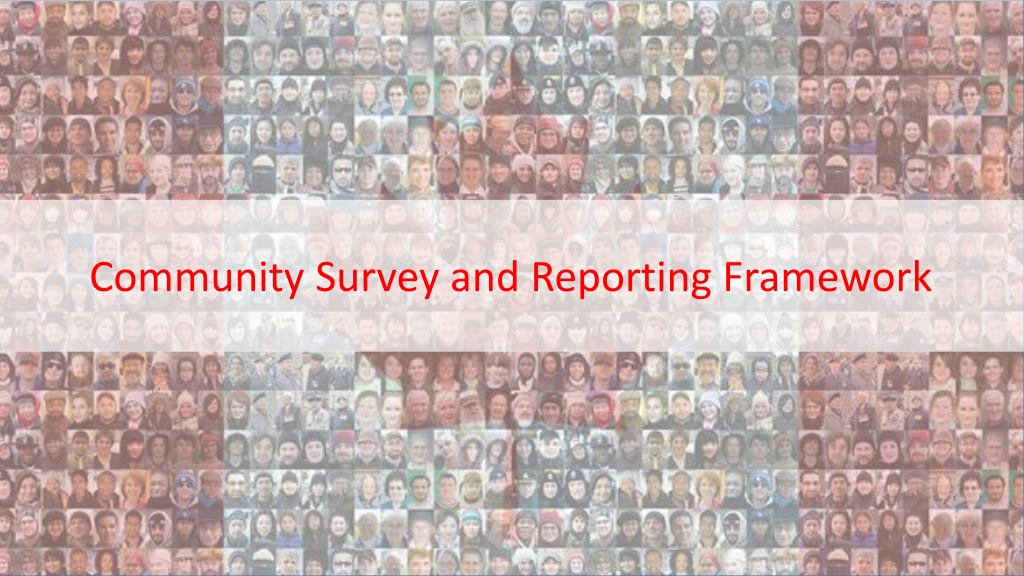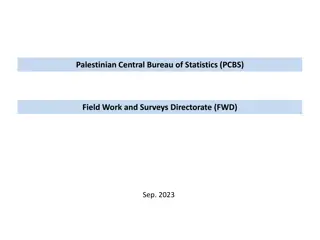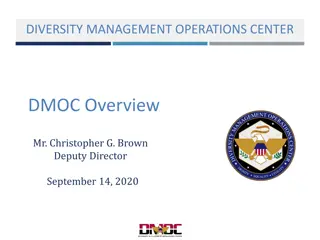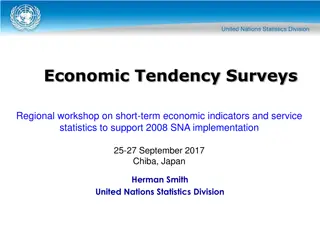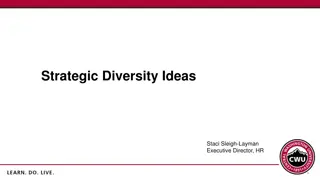Enhancing Workplace Diversity through Comprehensive Demographics Surveys
Utilize comprehensive demographic surveys to enhance workplace diversity. Understand the importance of diverse representation, gather insights anonymously, and tailor inclusion efforts for a more inclusive work environment. Survey results aid in identifying areas for improvement and aligning policies effectively.
- Workplace Diversity
- Demographics Surveys
- Diversity & Inclusion
- Inclusive Culture
- Employee Representation
Download Presentation

Please find below an Image/Link to download the presentation.
The content on the website is provided AS IS for your information and personal use only. It may not be sold, licensed, or shared on other websites without obtaining consent from the author. Download presentation by click this link. If you encounter any issues during the download, it is possible that the publisher has removed the file from their server.
E N D
Presentation Transcript
Version Control Version Date Primary Editor Organization Contact Info Comments 1.0 08/04/2017 Stephanie Little Hubba slittle@hubba.com Initial Public Draft
Participating Organizations Organization Organization Join Date Primary Point Of Contact Contact Info 1.0 08/04/2017 Stephanie Little Hubba slittle@hubba.com
Contents Why run a demographics survey Who to include in your survey What to ask Asking sensitive questions sensitively Collecting your responses Analyzing and presenting your results Full framework
Diversity Matters Diverse groups out-perform homogenous teams and should have proper representation in the workplace. Diversity goes beyond the surface level information many companies currently consider. It is also worth noting that People are diverse in many ways they may not officially disclose. A voluntary and anonymous survey will provide insight into how diverse your organization is, without putting anyone in an uncomfortable position.
Your Survey Results Will Help Identify areas where your company and teams are over or under represented Align policies to better serve your teams Communicate and showcase your personality and culture to applicants Tailor your Diversity & Inclusion efforts (communications, training, education, etc)
Contents Why run a demographics survey Who to include in your survey What to ask Asking sensitive questions sensitively Collecting your responses Analyzing and presenting your results Full framework
Employees From part-time to remote to executive team members, all employees should be included in survey for results that are truly representative of the company. Temporary employees, co-ops, interns etc. could potentially skew your data. In these cases, consider whether the role(s) are one-off short term positions (don t include) or if the role(s) will be consistently filled, like a co-op position or a longer term temp assignment (do include)
Independent Contractors / Freelancers / Outsourced teams? As they are not official employees, are not making or informing decisions that impact the business and team, and typically have little to no interaction with your team, it is recommended they should not be included.
Board Members and Investors With their direct impact on business and company direction, board members and investors are an important group to include in your diversity survey. Considering this group is not part of the employee base, a separate and/or less detailed survey may be more appropriate for this smaller group.
Contents Why run a demographics survey Who to include in your survey What to ask Asking sensitive questions sensitively Collecting your responses Analyzing and presenting your results Full framework
Standard Demographics Standard demographic questions should be included in all surveys and represent the areas of most frequent discrimination and bias. These include questions of age, gender, religion, nationality, race, ethnicity, disability, family and marital status, education and socio-economic background. The results of these questions will help identify the first layer of gaps that exist at your company.
General Interest General interest questions are optional but provide the information that will illustrate the personality of your organization. The results of these questions provide insight into the nuanced areas of diversity, those that illustrate your workforce s point of reference, add colour to your company s foundation and can uncover where varying viewpoints come from (or those that are over indexing).
Department / Level /Compensation This standard information that is usually already captured and on file through other avenues, becomes richer when you are able to analyze it with more detailed demographic data through your survey. For example: Survey Data Standard info on file Total # of employees # female # male ABC Co celebrates reaching 50% female headcount. M F O 2% Gender identity 50 % 85 % 90 % 80 % 48% 60 VS. Leadership roles 15% 0% 30 30 Earning above $X 8% 2% Engineers 18% 2% *example is very simplified. You would likely analyze a lot deeper than this. ABC Co investigates who/what has created these imbalances and how they
Engagement Where standard questions can offer insight into foundational diversity, engagement questions provide important awareness/understanding of the mood of your teams and can help guide areas of focus and prioritization as you continue to improve the organization. Results should influence you to look at whether diverse groups feel less engaged and whether those trends are company wide or isolated to specific department, and if credit or promotions are skewed in any particular way.
Contents Why run a demographics survey Who to include in your survey What to ask Asking sensitive questions sensitively Collecting your responses Analyzing and presenting your results Full framework
Sample Surveys Sample surveys have historically been over simplified and generic to a fault. The framework provided at the end of this guide has been drafted/constructed with an employee first mentality, designed specifically with employee empathy, consideration and respect. This survey began with Project Include to create the demographic framework and Culture Amp for engagement, expanded to be modular, and adapted to better suit Canadian organizations. This adaptation also includes additional topics that could be of interest to select organizations.
More Options to Select From The value of listing more options is richer data and a better understanding of your employee base so you can grow your teams in meaningful, diverse and inclusive ways. In a category with near endless options such as language or religion, adding 10-25 options and including an other option is usually fine.
The OTHER Option Even the most thoughtful and inclusive surveys will require an OTHER option. There is always a chance that a possible option has not been included. The value of OTHER increases and is more respectful when it is more than a check-box or radio button - be sure to include a text box and offer employees and option to expand and explain if they choose. This creates an opportunity for any missed groups to self- identify, and improve future surveys and the organization.
Simple & Clear Keep all survey options clear and simple. It is important to ensure questions are not leading or derogatory even if unintentional. It is worth noting that too much detail can also hinder an employee s ability to respond if they don t identify an option that fits. Instead of this . Do you consider yourself religious? Consider this . Do you consider yourself Religious? Yes, very. It's a factor in my daily life and I follow all or most of the rules and rituals Yes, somewhat. It means a lot to me but I don't follow all of the rules and rituals Sort of - It's not a factor in my daily life but I do honour the main holidays of my religion and special occasions/ceremonies Not any more No Other (please specify) Yes Somewhat Faith - not religious Spiritual - not religious Not any more No Other (please specify)
Context for Clarity Context or definition at the beginning of a question can help ensure that all areas of the survey are properly interpreted and your data is more accurate. For example, Do you have a vision disability? (ie. not corrected by use of prescription lenses)
Reviews & Feedback Consider having your survey reviewed by a Diversity & inclusion or Human Rights Professional or lawyer if its an option for your organization. For best results, get feedback from employees who completed the survey. Include open-ended questions that offer opportunity for employees to offer suggestions for improvement, highlight if anything was insensitive, ask for clarification, or even give kudos.
Contents Why run a demographics survey Who to include in your survey What to ask Asking sensitive questions sensitively Collecting your responses Analyzing and presenting your results Full framework
Anonymity Anonymity matters in ensuring the validity of responses, and true representation of your employees. Removing the requirement for participants name and email and masking their IP address is a good start but does not provide the level of privacy needed to encourage participation and honest responses.
Anonymity (continued) The potential for identification issues can arise when cross referencing data from your standard demographics with departmental and engagement questions. If your departments are small, it is recommended that you combine departments to eliminate the potential of accidentally identifying individual employees. For example, if you only have one female engineer, you ll be able to identify details about 100% of your female engineers unless departments are combined. To maintain anonymity, enlist the help of an independent third party.
Independent Third Party Support If you have budget, there are third party firms that have out of the box or customizable options; they will collect responses on your behalf and return survey results in aggregate if you choose. SurveyMonkey or Google Forms provide budget-friendly alternative tools you can use along with credible, trustworthy and professional third party willing to export your summary data. When choosing your third party, if your budget allows, consider working with a Diversity & Inclusion / Human Rights Professional who can review your questions for any red flags.
Managing Responses Survey participation should be voluntary. Decide on minimum requirement for workforce participation and completion. The higher the percentage participation of your employee base, the more accurate and reflective of your organization the data is. Check your settings that employees can only submit survey responses once. 2-3 days is the recommended time to keep survey open for employees to complete, but feel free to extend timeline and send reminders as you see fit. If using a third party, request daily updates on responses to your survey response numbers.
Contents Why run a demographics survey Who to include in your survey What to ask Asking sensitive questions sensitively Collecting your responses Analyzing and presenting your results Full framework
Anonymity Again Protecting anonymity is especially important when sharing the results. Getting granular and specific with your questions gives you very rich and specific data that helps you understand your organization and prioritize your diversity and inclusion efforts based on results but this level of information is not necessarily safe to share. Take great care to study your stats before sharing and consider grouping information together to present in ways to eliminate risk of breaching employee s privacy.
Presenting Select important and interesting findings and present them in general terms. For example: Total # of Employees 80 Person(s) with Disability Disability Physical/Medical Vision/Hearing Mental/Addiction 9% of employees identify as having a disability # Yes Specify Severe arthritis Colour blind Anxiety, depression, OCD Autism, dyslexia 7 # No 73 = # 1 1 3 Cognitive/Learnin g 2
Sharing with Employees Share your (privacy filtered) information and your findings with your employees. They are interested in the breakdown of your organization, and this information should encourage participation in your future surveys. Transparency is appreciated. Acknowledge areas you think you can do better in, and what you plan to do to get there. Give them the opportunity to make suggestions, anonymously or not.
Repeating the Survey Every 6 months is recommended. Too often and your anonymity may be compromised and your participation will dwindle. Use the same questions for your repeat survey you used with the last survey with improvements or modifications based on feedback so that you can measure your progress more accurately.
Contents Why run a demographics survey Who to include in your survey What to ask Asking sensitive questions sensitively Collecting your responses Analyzing and presenting your results Full framework
Department / Level / Compensation Employee Type Permanent, Full Time Permanent, Part Time Co-op / Intern Temporary (6mo+ contract), Full time Temporary (6mo+ contract), Part Time Other (specify)
Department / Level / Compensation Department Engineering Product Management Marketing Sales Customer Success Business Development Operations People Finance Administration Other (specify)
Department / Level / Compensation Level Co-op/Intern Employee/Individual Contributor Supervisor Manager/Team Lead Department Lead/Director Executive
Department / Level / Compensation Compensation Annual salary (specify) Bonus potential (specify __%) Date of last salary increase (specify, enter N/A if you are under [X]months tenure) % of bonus potential awarded last review (specify, enter N/A if you are under [X]months tenure)
Engagement I would recommend [COMPANY] as a great place to work Strongly Agree Agree Neutral Disagree Strongly Disagree Comment: [COMPANY] motivates me to push beyond what I would in a similar role elsewhere Strongly Agree Agree Neutral Disagree Strongly Disagree Comment:
Engagement I see myself still working at [COMPANY] in two years time Strongly Agree Agree Neutral Disagree Strongly Disagree Comment: The leaders at [COMPANY] demonstrate that people are important to the company s success Strongly Agree Agree Neutral Disagree Strongly Disagree Comment:
Engagement I have confidence in the leaders at [COMPANY] Strongly Agree Agree Neutral Disagree Strongly Disagree Comment: I feel I am part of a team Strongly Agree Agree Neutral Disagree Strongly Disagree Comment:
Engagement The information I need to do my job effectively is readily available Strongly Agree Agree Neutral Disagree Strongly Disagree Comment: I am appropriately involved in decisions that affect my work Strongly Agree Agree Neutral Disagree Strongly Disagree Comment:
Engagement We have enough autonomy to perform our jobs effectively Strongly Agree Agree Neutral Disagree Strongly Disagree Comment: Workloads are divided fairly among people where I work Strongly Agree Agree Neutral Disagree Strongly Disagree Comment:
Engagement Other departments at [COMPANY] collaborate well with us to get the job done Strongly Agree Agree Neutral Disagree Strongly Disagree Comment: My manager keeps me informed about what is happening Strongly Agree Agree Neutral Disagree Strongly Disagree Comment:
Engagement My manager gives me useful feedback on how well I am performing Strongly Agree Agree Neutral Disagree Strongly Disagree Comment: My manager (or someone in management) has shown a genuine interest in my career aspirations Strongly Agree Agree Neutral Disagree Strongly Disagree Comment:
Engagement I believe there are good career opportunities for me at [COMPANY] Strongly Agree Agree Neutral Disagree Strongly Disagree Comment: I receive appropriate recognition for good work at [COMPANY] Strongly Agree Agree Neutral Disagree Strongly Disagree Comment:
Engagement Generally, the right people are rewarded and recognized at [COMPANY] Strongly Agree Agree Neutral Disagree Strongly Disagree Comment:
Age What is your age bracket? Under 21 21-25 26-30 31-35 36-40 41-45 46-50 51-55 56-60 61-65 Over 65
Race & Ethnicity No If no, please specify the country you were born in Were you born in Canada? Yes Were your biological parents born in Canada? Yes, one Yes, both No Unsure How many of your biological grandparents were born in Canada? 0 1 2 3 4 Unsure
